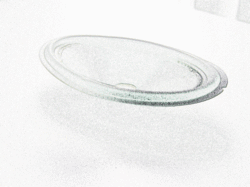Radiators and enclosures
Applications
- Woofer
- Tweeter
- Wide-band transducer
- Other loudspeakers and Transducers
Application Notes
Particularities
A force generated by the electro-mechanical transducer excites the radiator to mechanical vibration (as a rigid body or to bending or longitudinal modes). Any point of the vibrating surface (cone, diaphragm, panel) contributes as a small sound source (monopole and dipole) to the radiated sound. However, the non-vibrating boundaries (baffle, enclosure, horn, transmission line, …) affect the radiation condition (e.g. radiation impedance), sound transmission and the generated sound field.
Most loudspeaker parts behave both ways, as a radiator and as a sound transmission part. For example, enclosure walls assumed to be rigid may break-up to bending modes and vibrate sound. The outer part of a paper cone does not vibrate at higher frequencies but behaves as a sound transmission part for the sound radiated by the dust cap.
The shape of the surface (boundary) of the radiator and the sound transmission part directly determine the radiation and sound propagation condition. For predicting the mechanical vibration by finite element analysis, additional geometrical characteristics (e.g. thickness of the cone) and material parameters (Young’s E modulus, loss factor) are required. The properties of the materials used in paper cones and other radiators highly depend on temperature, humidity and may vary over time.
Mechanical measurements using laser sensors are very useful for measuring material parameters, performing modal analysis on radiators and predicting the sound pressure output. Note, measurements of material properties are usually performed on flat probes, and radiator is usually assessed in the final transducer.
Challenges in the Design
- Radiators operating over a wide range as a rigid body
- Desired bending and longitudinal vibration above break-up
- Low amplitude of the first circumferential mode (“rocking mode”)
- Desired radiation characteristics (directivity)
- Sound radiating area on the radiator shrinks at higher frequencies
- Sound pressure level and sound power level are close to accumulated acceleration level (AAL)
- Most important characteristics:
- Accumulated acceleration level (AAL) summarizes mechanical vibration on the radiator’s surface
- AAL of the radial (axial-symmetrical) and circumferential vibration mode
- On-axis SPL response, sound power response, directivity
- Sound pressure related decomposition (in-phase, anti-phase, quadrature component)
- Natural frequencies, loss factor, shape of vibration modes)
- Young’s E modulus of the material
- Loss factor or quality factor of the material
Critical Issues
- Low modal density of the mechanical vibration on the radiator at higher frequencies
- Low modal loss factor in the material generating high AAL at the natural frequencies
- Small differences between in-phase component and anti-phase component indicates an acoustical cancellation problem
- High mechanical vibration at a particular point on the radiator indicates high deformation of the local geometry causing nonlinear signal distortion
Standards
American Society for Testing and Materials
ASTM E111-04 Standard Test Method for Young's Modulus, Tangent Modulus, and Chord Modulus
ASTM E 756 Standard Test Method for Measuring Vibration-Damping Properties of Materials
Most relevant Measurements | Modules of R&D SYSTEM | Modules of QC SYSTEM |
|---|---|---|
3D-geometry scanning |
| |
Distributed mechanical parameters | Higher Modal Analysis (HMA) |
|
Accumulated acceleration level (AAL) |
| |
Modal analysis (natural frequencies, shape of modal vibration, modal loss factor) | Higher Modal Analysis (HMA) |
|
Decomposition into radial and circumferential mode | Rocking Mode Analysis (RMA) Scanning Vibrometer System (SCN) |
|
On-axis sound pressure amplitude response | Higher Modal Analysis (HMA) | Spectrum Analysis (SAN) |
Directional characteristics (directivity index, coverage angle, radiation angle, polar radiation measurement) |
| |
Sound power response | Near Field Scanner (NFS) |
|
Sound pressure related decomposition |
| |
Effective radiation area Sd |
| |
Material parameters | Higher Modal Analysis (HMA) |
|

